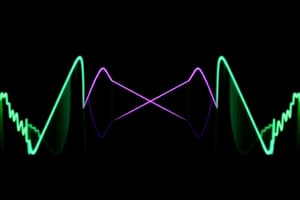Podcast
Questions and Answers
What is the primary role of collateral in the context of repo transactions?
What is the primary role of collateral in the context of repo transactions?
- To facilitate the transfer of ownership of securities
- To serve as a protection against default (correct)
- To enhance the yield of the underlying assets
- To provide liquidity for cash transactions
What does the term 'specials' refer to in repo transactions?
What does the term 'specials' refer to in repo transactions?
- The use of collateral that is highly valued by the market
- The borrowing of money in unsecured loans
- The lending of specific securities rather than cash (correct)
- Short-term investment funds targeting high returns
What advantage does the seller have in a repo transaction concerning collateral?
What advantage does the seller have in a repo transaction concerning collateral?
- The power to enforce penalties on the buyer
- The ability to sell the collateral freely during the term
- The right to set the repo rate independently
- The option to recall and substitute collateral of equivalent value (correct)
Why might a delivery repo be considered the most expensive option?
Why might a delivery repo be considered the most expensive option?
In a hold in custody (HIC) repo, who maintains custody of the collateral?
In a hold in custody (HIC) repo, who maintains custody of the collateral?
What does the swap seller pay in a fixed-for-floating swap?
What does the swap seller pay in a fixed-for-floating swap?
Which party benefits from anticipating a rise in interest rates in a fixed-for-floating swap?
Which party benefits from anticipating a rise in interest rates in a fixed-for-floating swap?
What is the main risk associated with swaps from the perspective of a variable rate investment?
What is the main risk associated with swaps from the perspective of a variable rate investment?
In a currency swap, what replaces the notional amount common in interest rate swaps?
In a currency swap, what replaces the notional amount common in interest rate swaps?
What does the Swiss bank effectively fund at through the currency swap after issuing a CHF Bond?
What does the Swiss bank effectively fund at through the currency swap after issuing a CHF Bond?
Which of the following best describes a covered bond?
Which of the following best describes a covered bond?
What do both participants in a fixed-for-floating swap exchange regarding their fixed and variable payment expectations?
What do both participants in a fixed-for-floating swap exchange regarding their fixed and variable payment expectations?
What is a common strategy for using swaps as a financial instrument?
What is a common strategy for using swaps as a financial instrument?
What is the term for the amount that represents the difference between the observed rate and the guaranteed rate in a financial transaction?
What is the term for the amount that represents the difference between the observed rate and the guaranteed rate in a financial transaction?
What calculation does the formula for repo interest amount include?
What calculation does the formula for repo interest amount include?
What does the haircut refer to in the context of the dirty price of a bond?
What does the haircut refer to in the context of the dirty price of a bond?
What is a characteristic of a callable bond?
What is a characteristic of a callable bond?
In a Forward Rate Agreement (FRA), what does FRA (3*6) represent?
In a Forward Rate Agreement (FRA), what does FRA (3*6) represent?
What is the primary purpose of over-the-counter (OTC) derivatives?
What is the primary purpose of over-the-counter (OTC) derivatives?
Why do callable bonds typically pay higher coupons than straight bonds?
Why do callable bonds typically pay higher coupons than straight bonds?
What situation would benefit an issuer of a callable bond?
What situation would benefit an issuer of a callable bond?
What is the implication for the buyer in a rate agreement when anticipating a potential rise in rates?
What is the implication for the buyer in a rate agreement when anticipating a potential rise in rates?
How does the price of a callable bond typically compare to that of a straight bond?
How does the price of a callable bond typically compare to that of a straight bond?
In the repo interest calculation, which term refers to the initial value adjusted for any haircuts?
In the repo interest calculation, which term refers to the initial value adjusted for any haircuts?
What advantage does a putable bond provide to the investor?
What advantage does a putable bond provide to the investor?
Which of the following statements about the seller in a rate agreement is true?
Which of the following statements about the seller in a rate agreement is true?
What is one risk that investors face with callable bonds?
What is one risk that investors face with callable bonds?
What does a higher yield on a callable bond indicate compared to a straight bond?
What does a higher yield on a callable bond indicate compared to a straight bond?
How does the price of a putable bond normally compare to other types of bonds?
How does the price of a putable bond normally compare to other types of bonds?
What distinguishes covered bonds from corporate bonds in the event of issuer insolvency?
What distinguishes covered bonds from corporate bonds in the event of issuer insolvency?
What obligation does the credit institution have regarding the cover pool of a covered bond?
What obligation does the credit institution have regarding the cover pool of a covered bond?
Which of the following best characterizes a key difference between covered bonds and securitization?
Which of the following best characterizes a key difference between covered bonds and securitization?
What is the primary feature of a cover pool in a covered bond?
What is the primary feature of a cover pool in a covered bond?
Which financial assets are most common in the cover pool of covered bonds?
Which financial assets are most common in the cover pool of covered bonds?
What does overcollateralization refer to in the context of covered bonds?
What does overcollateralization refer to in the context of covered bonds?
What regulatory requirement applies to the issuance of covered bonds?
What regulatory requirement applies to the issuance of covered bonds?
How does the credit institution's obligation differ between covered bonds and securitization?
How does the credit institution's obligation differ between covered bonds and securitization?
What is a key reason for a company to issue putable bonds?
What is a key reason for a company to issue putable bonds?
What defines a convertible bond's intrinsic value?
What defines a convertible bond's intrinsic value?
How does the yield on a putable bond typically compare to that of a straight bond?
How does the yield on a putable bond typically compare to that of a straight bond?
What is the primary reason for the lower coupon rates of inflation-linked bonds compared to nominal bonds?
What is the primary reason for the lower coupon rates of inflation-linked bonds compared to nominal bonds?
What is the relationship between the price of a putable bond and a straight bond?
What is the relationship between the price of a putable bond and a straight bond?
What benefit does an investor gain from a convertible bond?
What benefit does an investor gain from a convertible bond?
In the context of bonds, what does the term 'premium' indicate?
In the context of bonds, what does the term 'premium' indicate?
What adjustment does an inflation-linked bond make to its cash flows over time?
What adjustment does an inflation-linked bond make to its cash flows over time?
What does 'parity' refer to in the context of convertible bonds?
What does 'parity' refer to in the context of convertible bonds?
What describes the 'clean price' of a bond?
What describes the 'clean price' of a bond?
Flashcards
Repo
Repo
A secured form of borrowing and lending money using specific securities as collateral. The borrower receives cash and gives the lender securities, and they agree to reverse the transaction later.
Repo Rate
Repo Rate
The interest rate charged by the lender in a repurchase agreement. It can be positive, zero, or even negative, depending on market demand.
Substitution Right
Substitution Right
The seller in a repo has the right to recall the collateral and replace it with another security of equal value and quality.
Delivery Repo
Delivery Repo
Signup and view all the flashcards
Hold in Custody (HIC) Repo
Hold in Custody (HIC) Repo
Signup and view all the flashcards
Bullet Bond
Bullet Bond
Signup and view all the flashcards
Callable Bond
Callable Bond
Signup and view all the flashcards
Why does the issuer have the advantage with a callable bond?
Why does the issuer have the advantage with a callable bond?
Signup and view all the flashcards
What is the compensation for the investor in a callable bond?
What is the compensation for the investor in a callable bond?
Signup and view all the flashcards
How does the price of a callable bond compare to a straight bond?
How does the price of a callable bond compare to a straight bond?
Signup and view all the flashcards
Putable Bond
Putable Bond
Signup and view all the flashcards
What advantage does the investor have with a putable bond?
What advantage does the investor have with a putable bond?
Signup and view all the flashcards
Why would the investor want a put option with a putable bond?
Why would the investor want a put option with a putable bond?
Signup and view all the flashcards
Interest Rate Swap
Interest Rate Swap
Signup and view all the flashcards
Currency Swap
Currency Swap
Signup and view all the flashcards
Vanilla Swap
Vanilla Swap
Signup and view all the flashcards
Swap Seller
Swap Seller
Signup and view all the flashcards
Swap Buyer
Swap Buyer
Signup and view all the flashcards
Covered Bond
Covered Bond
Signup and view all the flashcards
Hedging Interest Rate Risk
Hedging Interest Rate Risk
Signup and view all the flashcards
Net Cash Flow Through Currency Swap
Net Cash Flow Through Currency Swap
Signup and view all the flashcards
Repo (Repurchase Agreement)
Repo (Repurchase Agreement)
Signup and view all the flashcards
Haircut
Haircut
Signup and view all the flashcards
Dirty Price
Dirty Price
Signup and view all the flashcards
Repo Interest
Repo Interest
Signup and view all the flashcards
Forward Rate Agreement (FRA)
Forward Rate Agreement (FRA)
Signup and view all the flashcards
FRA (3*6)
FRA (3*6)
Signup and view all the flashcards
Speculation with FRA
Speculation with FRA
Signup and view all the flashcards
Hedging with FRA
Hedging with FRA
Signup and view all the flashcards
Why are putable bonds more expensive?
Why are putable bonds more expensive?
Signup and view all the flashcards
Convertible Bond
Convertible Bond
Signup and view all the flashcards
Benefits of Convertible Bonds for Issuers
Benefits of Convertible Bonds for Issuers
Signup and view all the flashcards
Benefits of Convertible Bonds for Investors
Benefits of Convertible Bonds for Investors
Signup and view all the flashcards
Parity
Parity
Signup and view all the flashcards
Premium
Premium
Signup and view all the flashcards
Inflation-Linked Bond
Inflation-Linked Bond
Signup and view all the flashcards
How does Inflation affect Inflation-Linked Bonds?
How does Inflation affect Inflation-Linked Bonds?
Signup and view all the flashcards
Why do Governments Issue Inflation-Linked Bonds?
Why do Governments Issue Inflation-Linked Bonds?
Signup and view all the flashcards
Cover Pool
Cover Pool
Signup and view all the flashcards
Overcollateralization
Overcollateralization
Signup and view all the flashcards
Full Recourse Right
Full Recourse Right
Signup and view all the flashcards
How does a covered bond differ from securitization?
How does a covered bond differ from securitization?
Signup and view all the flashcards
What are the common cover assets for covered bonds?
What are the common cover assets for covered bonds?
Signup and view all the flashcards
Why is public supervision important for covered bonds?
Why is public supervision important for covered bonds?
Signup and view all the flashcards
Ongoing obligation
Ongoing obligation
Signup and view all the flashcards
Study Notes
Black-Scholes-Merton Formula
- Applies to European options on non-dividend-paying stocks
- Formula for call option price: C = So • N(d₁) – Ke-rT. N(d2)
- Variables:
- C = Call option price
- So = Current stock price
- K = Strike price
- r = Risk-free interest rate
- T = Time to maturity (in years)
- σ = Volatility of the stock
- N() = Cumulative distribution function of the standard normal distribution
- d1: ln(So/K)+(r+σ²/2)Τ/σ√Τ
- d2: d₁ - σ√T
Option to Delay
- Allows firms to avoid "bad" outcomes by delaying decisions
- You lose some sales on delay
- Avoid investment losses by delaying if the market turns bad
- Examine if NPV now or delaying is more worthwhile
Bond Issuance and Debt Capital Markets
- Corporations finance using debt and equity
- Key differences from issuer and investor perspectives:
- Debt: Promise to pay according to a schedule
- Bond: Legal commitment; failure leads to bankruptcy
- Repayment of principal is guaranteed
- Equity: Payment is discretionary; management decides dividends or not
- Debt: Promise to pay according to a schedule
Hybrid Bonds
- Include call/put options
- Bullet bond: Coupon and principal repaid at maturity
- Callable bond: Issuer can repay ahead of schedule if interest rates fall. Callables have higher coupons than straight bonds to compensate prepayment risk.
- Putable bond: Investor has right to demand repayment. Putables have higher price than straight bonds, adding value for investor.
Convertible Bond
- Allows holder to exchange principal for issuer's security (e.g., equity)
- Combines features of debt and equity
- Pays fixed coupon and has a maturity date
- Investors participate in the issuing company's performance
Parity
- The option's intrinsic value
- Premium: Bond price less parity, indicating how much more costly it is to buy underlying shares indirectly.
Inflation-Linked Bonds (TIPS)
- Interest and principal payments adjusted for inflation
- Coupon payments vary based on the price index
- Principal repayment adjusts to inflation
- TIPS = (interest + principal) * inflation over time
- Dirty price of TIPS = (clean price + accrued interest) * index ratio (inflation)
- Governments issue for reduced financing costs and credibility.
- Investors buy to hedge against inflation risk.
Repo Operations
- Contract for selling and repurchasing securities over a specified period
- Repo is used for short- or long-term positions.
- Repo involves interest.
- Collateral use: Collateral is essential to protect the buyer from seller default.
- Legal ownership: Buyer doesn't own the collateral unless the seller defaults
- Advantage to seller/buyer: Liquidation of collateral, etc.
OTC Derivatives (e.g., Forward Rate Agreements)
- Over-the-counter contracts to determine interest rate at a future date
- Used for speculation or hedging against interest rate risk
Currency Swaps
- Exchange of interest payments in different currencies.
- Involves two principal amounts at swap start, and again at maturity.
Covered Bonds
- Debt issued by a credit institution
- Has preferential recourse to collateral (cover pool) during insolvency
- Bondholders are prioritized over unsecured creditors.
- Cover pool must exceed the covered bonds amount, with ongoing obligation to the bondholders.
- Attractive to institutions as a long term funding opportunity, reducing refinancing risk.
Studying That Suits You
Use AI to generate personalized quizzes and flashcards to suit your learning preferences.




